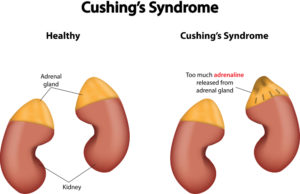 Cushing’s disease is a hormonal condition that is usually only found in older dogs. Any breed of dog can get Cushings Disease but it is more common in older dogs at about 10 or 11 years old and more common in breeds such as Boxers, Terriers, Staffordshire, Poodles, Jack Russells and Beagles. Cushing disease is also found in horses but rarely with cats.
Cushing’s disease is a hormonal condition that is usually only found in older dogs. Any breed of dog can get Cushings Disease but it is more common in older dogs at about 10 or 11 years old and more common in breeds such as Boxers, Terriers, Staffordshire, Poodles, Jack Russells and Beagles. Cushing disease is also found in horses but rarely with cats.
Cushing’s disease is brought about by tumours that form in the adrenal gland or in the pituitary glands and they cause the dog to produce too much Cortisol, which is a hormone.
Signs are often missed as people think that the dog is just getting old and they also come on slowly so they are often missed.
Signs include:
- Mobility problems which are often confused with Arthritis
- Poor coat condition
- Fur loss often in the same place on both sides of the dog
- Sometimes dark spots are visible on the tummy
- Thirst
- Excessive urination
- Weight gain
- Anorexia
- Low immune system and more prone to infections in the ears, skin and urinary tract
- Lethargy
- Depression
- Loss of “zest for life”
- Aimless wandering or circling
If you suspect Cushings Disease take the dog to your vet and he will be able to carry out blood tests and urine tests to look for certain hormones and enzymes. Sometimes they will carry out a CT scan to see the area where the tumours are likely to be.
If untreated Cushing’s disease can lead to conditions such as heart problems, diabetes, seizures and a high blood pressure.
Treatment the vet will advise will focus on improving the dogs quality of life rather than eradicating the disease. Once under control in a few weeks, they can live on for years.
Finally, make sure you get them checked out by a vet and not just put these symptoms down to old age as the sooner they receive treatment, the better the outcome.


Pingback: Diabetes Type 1 your body is unable to produce any insulin.Type I diabetes
Pingback: Lyme disease is a dangerous disease and it can be carried by ticks
Pingback: Ticks are different from stings because tick stays on body sucks blood out
Pingback: Dog microchipping in England is compulsory from April 2016
Pingback: Why is pet food important for a healthy diet for dogs and cats